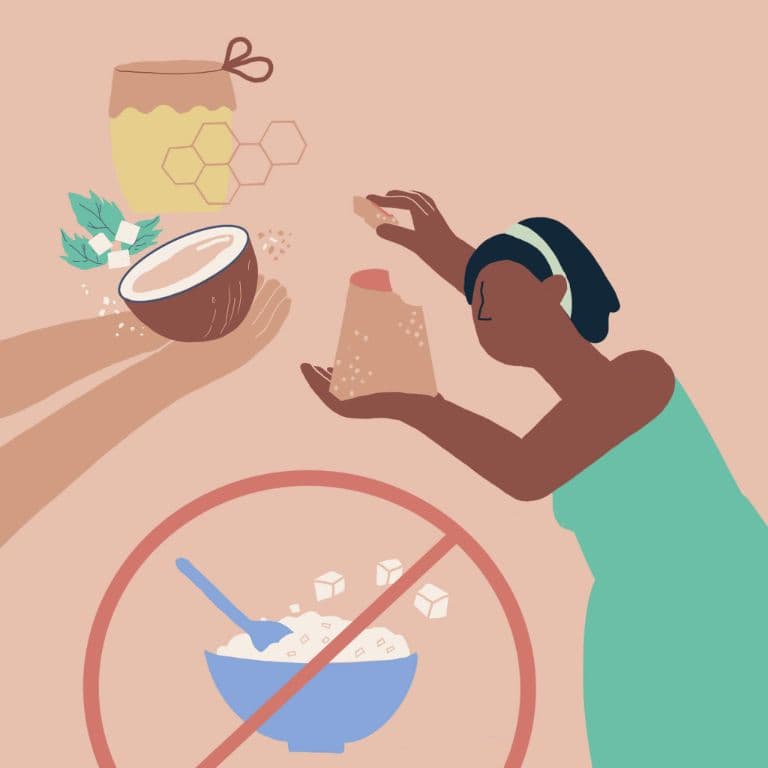This blog has been compiled by Komal Adhlaka, a content writer for Proactive For Her.
Sugars are carbohydrates. Our body breaks down carbohydrates into simple sugars, such as glucose, that can be readily used in the body. While some sugar is organically present in the food we eat, like fruit or dairy, extra sugar is added to all sorts of processed foods. From the sweet items we would expect to be sugary, like chocolate bars, etc., added sugars in our everyday food items can mean that we’re consuming a lot of extra sugar.
Why is it bad for you?
Sugar is added to many foods, and eating a lot of the sweet stuff—in any event, when it appears to come from a natural source—can encourage weight gain, heart disease, diabetes, hypertension, etc. A diet with heavy amounts of sugar is connected to a danger of heart disease regardless of your weight.
Sugar is processed and ingested quickly, and this causes a rise in your blood sugar levels. That challenges your pancreas to siphon out more insulin. If the pancreas can't stay aware of that demand, blood sugar levels rise, which can prompt more problems with insulin secretion, and eventually to diabetes. Sugar also raises inflammation all through the body, increases fatty substances, and lifts the levels of dopamine in the mind. Dopamine gives you a high, and that is the reason the more sugar you eat, the more you think you need.
What are some sugar aliases?
The sweet ingredient goes by many different names on food labels. Look for these added sugars when you read ingredient lists:
- agave nectar
- honey
- brown sugar
- corn sweetener
- corn syrup
- crystalline fructose
- cane sugar
- dextrose
- fructose
- glucose
- sucrose
- high-fructose corn syrup
- invert sugar
- lactose
- malt sugar
- malt syrup
- maltose
- cane crystals
- maple syrup
- evaporated cane juice
- molasses
- raw sugar
- fruit juice concentrates
Sources of Hidden Sugars
- Yogurt is rich in calcium and protein. Low-fat flavored yogurts can have 20 to 30 grams of sugar per 8-ounce serving. That’s about as much as 2 scoops of ice cream.
- A lot of granola bar brands add sweeteners like honey, corn syrup, brown sugar, dextrose, and fructose. Some have a yogurt or chocolate or chocolate chips coating on them, which can ramp up the sugars fast.
- Fruit-flavored Oatmeal has 10-15 grams of sugar in a single packet. “Reduced sugar” varieties can have about 5 grams in a single packet.
- Many kids’ cereal brands like Kelogg’s corn flakes, etc. that contain oat, corn, and bran have about 15 grams or more per cup. No matter what the nutritional label promises, there’s no denial of its sugar content.
- Salad toppings that contain fruit or honey, etc. have about 5 grams of sugar in just 2 tablespoons of dressing.
- Dried fruits contain more sugar by volume than fresh fruits. For example, a box of raisins that weighs 1 ounce has more than 25 grams of sugar. (Moderation is the key for dry fruit consumption).
- Sometimes, energy drinks contain lots of sugar and caffeine. They have about 20 grams per 6-ounce serving.
- At about 5 grams of ketchup in a tablespoon, spread on your sandwich can give you a minor sugar boost.
- Many popular brands of flavored iced tea, for example, all have about 30 grams of sugar in a bottle while A cup of apple juice has more than 20 grams.
How to avoid hidden sugar?
1. Avoid added sugar
A lot of people don’t know the difference between natural and added sugar. So, make sure you know it. Added and free sugars are added over and above the already existing sugars to edible products by the manufacturer or consumer.
Juices (and concentrates), honey, syrups, etc, all contain free sugar. Added sugar isn’t good for overall health. Therefore, added sugar content intake should be limited. Intrinsic or naturally occurring sugars are found in whole foods such as whole grains, fruit, vegetables, and dairy. They are present alongside other nutrients as water, fiber, vitamins, and minerals, which are beneficial for a healthy diet.
2. Read the label of packaged foods
Read product labels and check their ingredient content for any of the sugar alias, as well as Nutrition Information Panel for total sugar content. Remember, 1 teaspoon of sugar equals 4.2 grams. Foods considered ‘low sugar’ contain about 4-5 grams or less of total sugar per 100g. Reading the label helps to limit added sugar intake to 6 teaspoons (25g) daily.
3. Focus on proteins, fiber, and healthy fat
Grab some fiber, healthy fat, and/or protein, like almonds, and avocado to satiate your snack cravings. Fiber makes you full for longer and stabilizes energy. It also reduces the likelihood of choosing a quick sugary fix again and again.
4. Eat whole foods
A whole food diet is a low sugar diet because it is not heavily processed, sugar-laden food. You can’t avoid sugar completely, you can still try healthier alternatives like jaggery to make your food more flavourful.
5. Avoid sugary beverages
Avoiding sugar-laden beverages is the quickest and easiest way to cut down on added and free sugars. You could replace your added sugar in tea or coffee with jaggery and a soft drink with plain soda water infused with fresh cucumber or berries. Also, fruit juices should be avoided as they contain added sugar. Fresh fruits would be a healthier option in this regard.
6. Drink enough water
Inadequate hydration leads the person to feel hungry, foggy-headed or exhausted. This increases the likelihood of eating food with sugar content. Therefore, stay hydrated throughout the day.
7. Relax
Eating while you’re stressed out is common, and often eating sugary foods for a mood boost is what we all end up doing. Try to divert your energy towards something that helps you relieve stress like yoga or anything else you love.
Final Words
Added sugars in general, regardless of type, are harmful to our health. You can reduce your intake by drinking fewer sugary drinks, choosing unsweetened products, and focusing on whole, unprocessed foods. When you’re at the store, look for food items that do not contain sugar or their alias names listed as one of the first three ingredients on the label. Remember that any change to your diet takes time and adjustment. These small steps may not feel comfortable or normal at first, but after a few weeks, you'll be living a lower sugar life and enjoying the benefits of a healthier diet and a healthier life.
Disclaimer - This information is provided for educational purposes and should not be construed as medical advice. Please consult with your healthcare practitioners before undertaking any changes in your diet or adding supplements.
Proactive For Her is a digital clinic for women, offering accessible, personalized, and confidential health-care solutions. We offer products and services for out-patient health concerns of Indian women, across their lifetime - from puberty to pregnancy to menopause. To know more on the sexual and reproductive health of women, visit https://www.proactiveforher.com/

